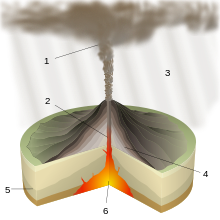Plinian eruption
The Plinian eruptions as part of volcanic events are extraordinarily explosive eruptions , which are associated with enormous ash falls . A few cubic kilometers of magma can be expelled within a few hours .
etymology
Plinian eruptions owe their name to the eyewitness and chronicler Pliny the Younger , who described the eruption of Vesuvius and the sinking of Pompeii and Herculaneum in AD 79 in two letters to the Roman historian Cornelius Tacitus . His uncle Pliny the Elder was killed in this outbreak.
procedure
The eruption consists of two phases:
- If magma pushing up to the surface of the earth is held up by rock layers, its pressure and / or the pressure of the gas contained in the magma can rise to such an extent that it forcibly blasts the obstacle away: remnants of the old plug are ejected upwards. Then the flow of material rushes up the chimney at a speed of up to several hundred meters per second , shreds of glowing lava and boulders from the crater wall.
- Above the crater, an eruption column forms that extends into the stratosphere . At high altitudes, the volcanic material cools down and "rains" down on the surroundings as lapilli . The collapse crater that remains is called the caldera .
- In a second phase, the dust and ash cloud collapses and forms the starting point of a pyroclastic flow .
In the eponymous, by Pliny d. The eruption of Vesuvius observed in the year 2000, Pompeii was buried by the lapilli precipitation, while Herculaneum was initially spared due to the wind direction, but was then buried by the pyroclastic currents. This led to great differences in the natural conservation of the two ancient cities.
Examples
Both the super volcanoes , flat volcanoes over huge magma chambers such as the Yellowstone volcano , and the stratovolcanoes , also known as stratovolcanoes or "gray volcanoes", can generate and form Plinian eruptions, among other things. a. the Pacific Ring of Fire .
Other famous Plinian eruptions were those of Santorini around 1627 BC. BC, the Tambora in 1816, the Krakatau in 1883, the Mount St. Helens in 1980 or the Pinatubo in 1991. The last eruption of the Laacher See in the Vulkaneifel is one of them.
literature
- Wallace-Hadrill, A .: Herculaneum 2012 (German edition)
